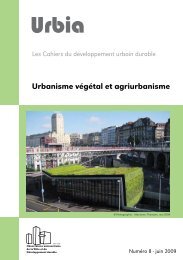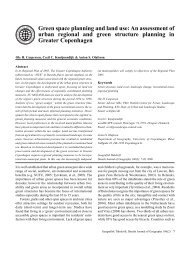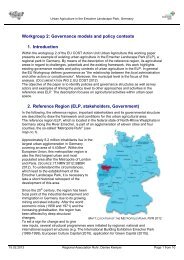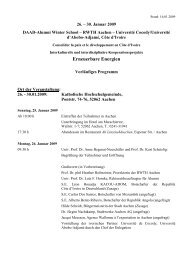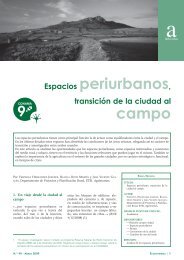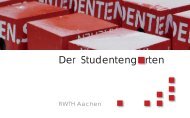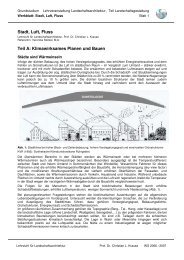Questionnaire for analyzing urban and peri-âurban agricultural ...
Questionnaire for analyzing urban and peri-âurban agricultural ...
Questionnaire for analyzing urban and peri-âurban agricultural ...
You also want an ePaper? Increase the reach of your titles
YUMPU automatically turns print PDFs into web optimized ePapers that Google loves.
<strong>Questionnaire</strong> <strong>for</strong> <strong>analyzing</strong> <strong>urban</strong> <strong>and</strong> <strong>peri</strong>-‐<strong>urban</strong> <strong>agricultural</strong> activities <br />
Preliminary remarks: COST Urban Agriculture Europe is a network of more than 120 European researchers <br />
from 61 universities <strong>and</strong> research institutions of 21 countries, which aims on putting issues of <strong>urban</strong> <strong>and</strong> <br />
<strong>peri</strong>-‐<strong>urban</strong> <strong>agricultural</strong> activities on the European policy agenda. Part of the project is to show the great <br />
diversity of activities <strong>and</strong> to demonstrate the important benefits <strong>for</strong> citizens <strong>and</strong> society -‐ a base <strong>for</strong> public <br />
support. By giving us in<strong>for</strong>mation <strong>and</strong> allowing us representing your activity in our “European Atlas on <br />
Urban Agriculture”, you help to strengthen the position of <strong>urban</strong> agriculture in Europe <strong>and</strong> to bring this <br />
sector in the awareness of local, regional <strong>and</strong> European politicians. Further on your participation in the <br />
“Atlas” can help you <strong>for</strong> your own public relations work. <br />
Every publication about your activity will be coordinated with you in advance; so we ask <strong>for</strong> your contact <br />
data: <br />
Name of responsible person: <br />
E-‐Mail: <br />
Website: <br />
Name of enterprise / project: <br />
Post address: <br />
1
1. Short description of the activity: <br />
Enterprise: ☐ <br />
Association: ☐ <br />
Project: ☐ <br />
Year of foundation: <br />
Years of activity: <br />
Production area (aprox. ha or square meter): <br />
Total area (apron. ha or square meter): <br />
Employed persons (paid, full time equivalent): <br />
Involved persons (volunteers, aprox.): <br />
Kind of crops <strong>and</strong> livestock: <br />
Production system (f.e. integrated, organic certified, organic, permaculture, conventional.....): <br />
Main services (f.e. educational activities, business events....): <br />
2
2. What is / are the purpose(s) of your activities Please indicate us, how important the <br />
proposed purposes are from your point of view: <br />
Purpose of the activity is... <br />
No <br />
importance <br />
Little <br />
Importance <br />
Certain <br />
Importance <br />
High <br />
Importance <br />
I can't say <br />
Commercial <br />
Self consumption/ <br />
social consumption <br />
Subsistence <br />
(production <strong>for</strong> food <br />
security) <br />
Educational <br />
Environment <br />
Protection/Area <br />
management <br />
Social <br />
Leisure / Well-‐being <br />
Customary use of <br />
L<strong>and</strong> (= tradition, <br />
expression of culture) <br />
Research & <br />
Development <br />
Others: <br />
which................. <br />
3
3. Short description of geographical situation, type of <strong>urban</strong> surrounding, agro-‐ecology, <br />
l<strong>and</strong>scape scenery (photos welcome! At least six: fields, products, people, buildings, l<strong>and</strong>scape.....) <br />
4
4. Markets <strong>and</strong> Marketing: <br />
What kind of specific expectations do the clients of your enterprise/project have, e.g. the population in the <br />
neighborhood of the enterprise/project (especially those which are taken into account) <br />
How would you describe the specific dem<strong>and</strong> or need, which your enterprise/project can cover with its <br />
offer <br />
What is the offer of the enterprise/project <strong>and</strong> the approach used to achieve it <br />
Which marketing channels are used to h<strong>and</strong> out products <strong>and</strong> services to clients <br />
5
How important is the local/regional market <strong>and</strong> the national/international market (rough estimate in %) <br />
Product 1:_______________ local/regional market (%) _____national/international market (%) ______ <br />
Product 2: _______________ local/regional market (%) _____national/international market (%)______ <br />
Product 3: _______________ local/regional market (%) _____national/international market (%)______ <br />
Product 4: _______________ local/regional market (%) _____national/international market (%)______ <br />
What makes your products or services unique compared to alternative providers <br />
5. Institutional environment: <br />
How is the public support of your enterprise <br />
How does the public limit your enterprise <br />
How is the l<strong>and</strong>ownership <br />
6
Which partnerships are you involved in (f.e. professional organizations, marketing alliances....) <br />
How is the physical planning designation <strong>for</strong> your operation (f.e. <strong>agricultural</strong> zone, industrial zone, <br />
residential zone, nature reserve.....) <br />
How does the Common Agricultural Policy affect your operation <br />
No affect: <br />
à Positively Please give examples: <br />
à Negatively Please give examples: <br />
7
VERY IMPORTANT! Which propositions, expectations <strong>and</strong> wishes do you have towards public support <strong>for</strong> <br />
your activities (including Common Agricultural Policy) <strong>and</strong> towards your clients <br />
6. Success factors: Which factors (reasons) make your activities successful <br />
7. Which are the principal problems that your activities are facing <br />
8
8. Macroeconomic benefits – or showing, what advantages bring your activities to the citizens <br />
<strong>and</strong> to the society as a whole! (Please help us with your data to strengthen the position of <strong>urban</strong> <br />
<strong>and</strong> <strong>peri</strong>-‐<strong>urban</strong> agriculture!) <br />
< 1.000 € <br />
per year <br />
1.000 € <br />
-‐ <br />
5.000 € <br />
per year <br />
5.001 € <br />
-‐ <br />
20.000 € <br />
per year <br />
20.001 € <br />
-‐ <br />
100.000 € <br />
per year <br />
100.001 € <br />
-‐ <br />
500.000 € <br />
per year <br />
> 500.000 € <br />
per year <br />
1. Production value <br />
(attention: not <br />
profit!!, aprox., <br />
estimated): <br />
None <br />
< 0,25 <br />
jobs <br />
per <br />
year <br />
0,25 -‐ 1 <br />
job <br />
per <br />
year <br />
2 -‐ 5 <br />
jobs <br />
per <br />
year <br />
6 -‐ 10 <br />
jobs <br />
per <br />
year <br />
> 10 <br />
jobs <br />
per <br />
year <br />
2. Number of full time jobs per year with <br />
salary including entrepreneurs (in full time <br />
equivalent, <strong>for</strong> taking into account half time <br />
<strong>and</strong> seasonal workers) <br />
3. Number of full time jobs without salary per <br />
year (volunteers; in full time equivalent) <br />
9
None <br />
< 100 <br />
persons x <br />
hours per <br />
year <br />
100 <br />
-‐ <br />
1.000 <br />
persons x <br />
hours per <br />
year <br />
1.001 <br />
-‐ <br />
5.000 <br />
persons x <br />
hours per <br />
year <br />
5.001 <br />
-‐ <br />
10.000 <br />
persons x <br />
hours per <br />
year <br />
> 10.000 <br />
persons x <br />
hours per <br />
year <br />
4. Persons receiving <br />
educational activities (in <br />
persons x hours per year; <br />
aprox., estimated) <br />
5. Persons receiving social <br />
activities (in persons x <br />
hours per year; aprox., <br />
estimated) <br />
None <br />
< 0,1 ha <br />
0,1 ha <br />
-‐ <br />
1,0 ha <br />
1,1 ha <br />
-‐ <br />
10,0 ha <br />
10,1 ha <br />
-‐ <br />
50,0 ha <br />
> 50,0 ha <br />
6. Managed green open space <br />
l<strong>and</strong> (fields, orchards, grasl<strong>and</strong>, <br />
<strong>for</strong>est, bushl<strong>and</strong>, gardens...) ha <br />
per year (aprox.) <br />
1 2 -‐ 5 6 -‐ 10 11 -‐ 20 21 -‐ 30 >30 <br />
7. Agrobiodiversity of production: Number <br />
of different varieties <strong>and</strong> races (plants <strong>and</strong> <br />
animals) produced <br />
10
8. Maintenance costs of preserved historical buildings, building monuments or natural monuments, if <br />
present (including historical/traditional parks <strong>and</strong> gardens; aprox., estimated), also <strong>urban</strong> green <br />
development costs, roads <strong>and</strong> foot paths <strong>for</strong> public use...... <br />
Remark: Value of own work has to be estimated <strong>and</strong> included <br />
None <br />
< 5.000 € per <br />
year <br />
5.000 € -‐ <br />
20.000 € per <br />
year <br />
20.001 € -‐ <br />
50.000 € per <br />
year <br />
50.001 € -‐ <br />
100.000 € per <br />
year <br />
> 100.000 € per <br />
year <br />
Summary: <br />
Remark: Levels 0 -‐ 5 in the cobweb diagram correspond to columns 1 -‐ 6 of the small tables of point 8 (macroeconomic <br />
benefits). The cobweb diagram visualizes the multifunctional benefits of <strong>urban</strong> <strong>and</strong> <strong>peri</strong>-‐<strong>urban</strong> <strong>agricultural</strong> activities. <br />
11
9. Personal profile of the initiator/owner: <br />
Age: <br />
Profession: <br />
Education: <br />
Gender: <br />
Family participation in the project/enterprise: <br />
Personal motivation: How did you get the idea <strong>for</strong> entering <strong>urban</strong> agriculture <br />
12
Space <strong>for</strong> own remarks <strong>and</strong> feedback: <br />
Name <strong>and</strong> institution of the interviewer: <br />
Thank you very much <strong>for</strong> your cooperation! <br />
Developed by Working group 3 “Professionals <strong>and</strong> entrepreneurial models of Urban agriculture” of COST-‐<br />
Action Urban Agriculture Europe (UAE): Oskar Alfranca, Gunilla Anderson, Ingve Berntsen, Galina Koleva, <br />
Wolf Lorleberg, Pedro Mendes Moreira, Terje Ong, Oleg Paulen, Bernd Pölling, Andreas Spornberger, <br />
Biancamaria Torquati <strong>and</strong> Jan-‐Willem van der Schans at COST Working group meeting Barcelona, 2013-‐03-‐<br />
14. <br />
13




